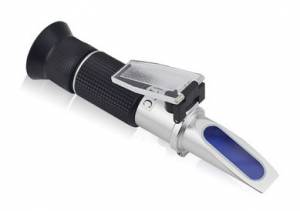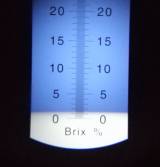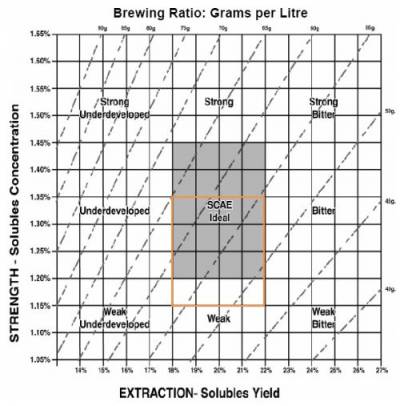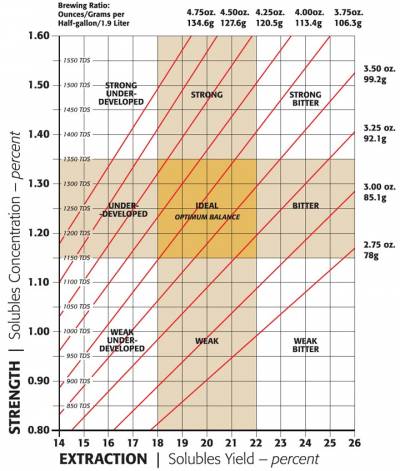Home » Blog » Refractometer and Coffee Extraction
Refractometer and Coffee Extraction
— Created: Xiaoke, 2017/05/06 23:52 CST
— Last modified: Xiaoke, 2017/05/16 23:17 CST
I read about coffee extraction from Scott Rao’s book: The Coffee Roaster's Companion. This topic is only briefly discussed in the book, centred around a sentence “Ideal extractions for most brewing methods are usually in the range of 19%-22%” and a device called refractometer. Refractometer uses light refraction to measure the concentration of a solution. I thought this 19%-22% was probably the reading of the refractometer.
 Searching on the internet, I found an ultra-expensive automatic device made by ATAGO, a Japanese company. This device is capable of giving two types of readings called TDS and Brix. Inspired by this clue and being ignorant about TDS and Brix, I bought a cheap Brix refractometer (~$15), naively hoping that it may give 20% reading of my coffee. The picture on the left shows how this 'economic' refractometer looks like.
Searching on the internet, I found an ultra-expensive automatic device made by ATAGO, a Japanese company. This device is capable of giving two types of readings called TDS and Brix. Inspired by this clue and being ignorant about TDS and Brix, I bought a cheap Brix refractometer (~$15), naively hoping that it may give 20% reading of my coffee. The picture on the left shows how this 'economic' refractometer looks like.
My coffee was brewed by a cupping procedure using 8g coffee beans plus 140 ml water. The reading of the refractometer was 2%. Surprised by the huge difference between the refractometer reading and my expectation, I searched on the internet and found that Brix actually stood for the percentage of sucrose in a solution by weight. 2% of sucrose in my coffee sounded pretty natural since my coffee was apparently not sweet. Then I made some sugar water of 16% Brix. The taste was so sweet that I would never forget. So ‘ideal’ coffee with 20% Brix was definitely wrong, suggesting there might be an error in the unit. Further digging on internet showed that 20% extraction meant that 20% weight/mass of the coffee ground had been dissolved in water. There are also a couple of coffee brewing control charts developed by SCAE and SCAA respectively (Specialty Coffee Association of Europe and America, respectively, now have merged as SCA) as shown in the pictures below.
Both charts define an optimal region in terms of the soluables yield (or extraction yield, in percentage) versus the total dissolved solids (TDS, in percentage or ppm). The two optimal regions both lie in the range of 19%~22% of soluables yield, while the SCAE chart prefers higher TDS (1.2%~1.45%) than its American counterpart (1.15%~1.35%). So in order to know whether my coffee lies in the optimal region or not, I had to find a way to convert the Brix reading to TDS. Fortunately, there exists an emperical formula saying that TDS is roughtly 0.85 * Brix. So my TDS was 2%*0.85 = 1.7%, suggesting my coffee was far too strong, no matter which chart was to be used.
 Then I decided to do a more precise test. This time I used a V60 dripper and followed the 60g line on the SCAE chart for a water-to-coffee ratio of 16.6. After the coffee settled at room tempearture of 23 degrees Celcius, I got 1.4% reading from the refractometer, as shown in the left figure. After adding a temperature correction term of +0.19%, the temperature-compensated Brix value was 1.59%, and the corresponding TDS was 1.35%. On the 60g line of the SCAE chart, 1.35% TDS corresponds to an extraction yield of roughly 19.5%. The point (19.5%, 1.35%) was apprently in the ideal region of the SCAE chart, so not bad.
Then I decided to do a more precise test. This time I used a V60 dripper and followed the 60g line on the SCAE chart for a water-to-coffee ratio of 16.6. After the coffee settled at room tempearture of 23 degrees Celcius, I got 1.4% reading from the refractometer, as shown in the left figure. After adding a temperature correction term of +0.19%, the temperature-compensated Brix value was 1.59%, and the corresponding TDS was 1.35%. On the 60g line of the SCAE chart, 1.35% TDS corresponds to an extraction yield of roughly 19.5%. The point (19.5%, 1.35%) was apprently in the ideal region of the SCAE chart, so not bad.

